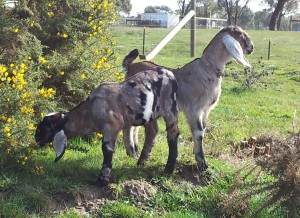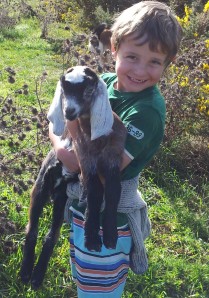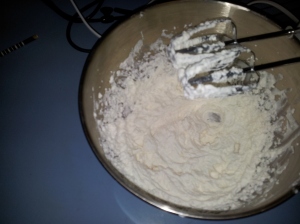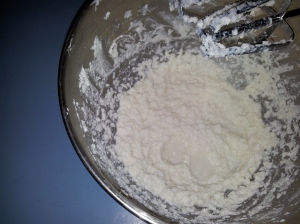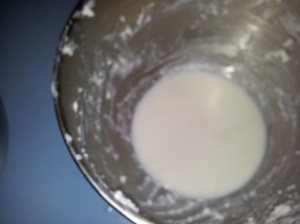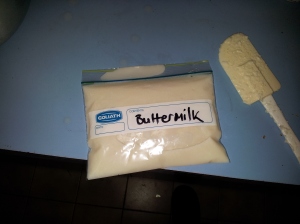I’ve got some new family members to introduce.
Kidding Season 2013 at Elcarim Farm was quite low-fuss as far as input from the does. But their timing made things a little tricky.
On July 10, with Sienna at 147 days and lugging around a huge udder, I was in hospital for the afternoon having my pacemaker generator replaced.
Now, the generator I had was probably good for another couple of months, but I didn’t want my surgery to clash with the Royal Melbourne Show. So instead it clashed with kidding.
After a big dose of sedative for my procedure, I went home and at last check (10pm) Sienna had a bit of white goo, a sign of labour beginning. Since she had trouble with her previous kidding, I felt it best not to take my eyes off her. Kidding finally started at around 2am, with three kids born by 4am. It was 5.30am before I got to bed. A night in a freezing cold barn (and it was freezing, thank goodness for the new ceramic heat lamp!) birthing goats is probably not what the doctors had in mind for me when they sent me home that afternoon.
I re-homed Sienna’s two buck kids at a couple of days old and left her with her fabulous little spotty doe kid.
Three days later, around 6am, Meredith kidded with no fuss. A big single doe kid. She can keep doing that every year, if she likes.
Then a couple of weeks later, Rianna decided to kid at feed time one afternoon. This would have been fine, except that I was once again in hospital (see previous post) and poor Matt had to deal with this kidding on his own. For her part, Rianna kindly kidded at a time when there was someone in the barn and only had two kids (she was enormous, I was expecting triplets or quads). She happily accepted both kids, who were a good size and vigorous.
So first of all, here is Elcarim Juno (the spotty one), by Jazzy Jupiter from Elcarim Sienna. And Elcarim Maia, by Jazzy Jupiter from Elcarim Meredith. This pair are best mates and hard to photograph separately.
Juno is a chubby, boisterous little girl, much like her mother in style, but hopefully with a bit more substance.
Maia is tall, upstanding and elegant, like her own mother. It will be very interesting showing this pair, as they are 3/4 related yet still quite different.
And then we have Rianna’s twins, by Capricorn Cottage Tazzy, Elcarim Zeus (front, with the big white splash) and Elcarim Hera
These kids are full siblings to Sienna. Hera is a lovely correct little doe, very feminine and with good type. Zeus is a strong and masculine fellow, born weighing 4kg. He seems to have Tazzy’s laid-back yet confident nature, so at this stage I will run him on as a buck with the view of him taking his father’s place in the future.
This year I am herd recording, which consists of doing a series of 24hour milk tests and sending in samples to determine the milk production of my does over their lactations. I did my first 24hour test this weekend, which gave me plenty of milk to use in the kitchen. As a result, I spent last night making soft cheese, butter, soap and yogurt, as well as the regular nightly setting of the kefir. I got some photos of the butter making process and thought I might share that with you all.
You can make butter with cream from the supermarket, if you want to give it a try. You will need a good electric mixer and some patience.
How to make butter
First you will need some cream, and it will need to be cold. I used cream separated from my goat milk, so my butter turned out white.
Whip the cream on a high setting until it thickens.
Then keep whipping it.
At a certain point my cream sticks to the edges of the bowl and the stand mixer can’t reach it, so I switch to the hand beater.
When you are starting to think that all you have done is ruin some nice cream, keep whipping. Then the cream will start to separate, I call it ‘breaking’ but I don’t know the real term for it. You will start to see the buttermilk looking watery in the bottom of the bowl.
Beat just a minute or two more. Then start to gather together the little blobs of fat. I use a spatula and pull the butter up the side of the bowl. When you have enough to pick up, squeeze it in your hand and pop it into a bowl of cold water. Squeeze it in the cold water to get as much of the buttermilk out as you can.
Pull together as much of the fat (butter) as you can with a spatula or your hands. You won’t get it all. When you are left with just buttermilk in your bowl you can either put it into a jar to store in the fridge or pour it into a ziplock bag to freeze and use later. It makes really good pancakes or scones, or you can look up recipes that use traditional buttermilk and experiment with something new.
Once I have all the buttermilk out of the bowl and as much of the butter as possible pulled together and rinsed as well as I can, I put the butter back in the bowl and add some salt. This is optional, but it helps preserve the butter and makes it taste more like the butter you will be used to. I basically squish the butter a bit flat, sprinkle the salt on, and mush it in with a spatula, picking up the butter from the sides of the bowl and expelling a little bit more buttermilk as I go. I discard this last bit of buttermilk as it has salt in it, not ideal for sweet baking.
Then just put the butter into airtight containers. I divide mine in two and keep one on the bench and the other in the fridge. You don’t want to leave it out too long.
I started this batch by separating five litres of milk, yielding about 200ml of cream. This made, as you can see, 84g of butter (I put the containers on, zeroed the scales, then put the butter in). I used up all the skim milk and I will use the buttermilk down the track, so nothing is wasted. It is a lot of work for a little bit of butter, but it is yum – great on toast – and easy to make.

